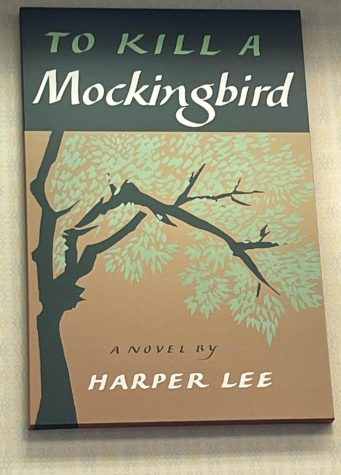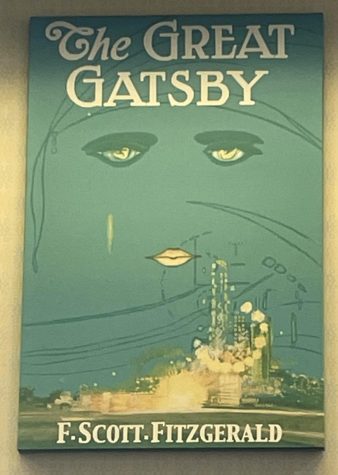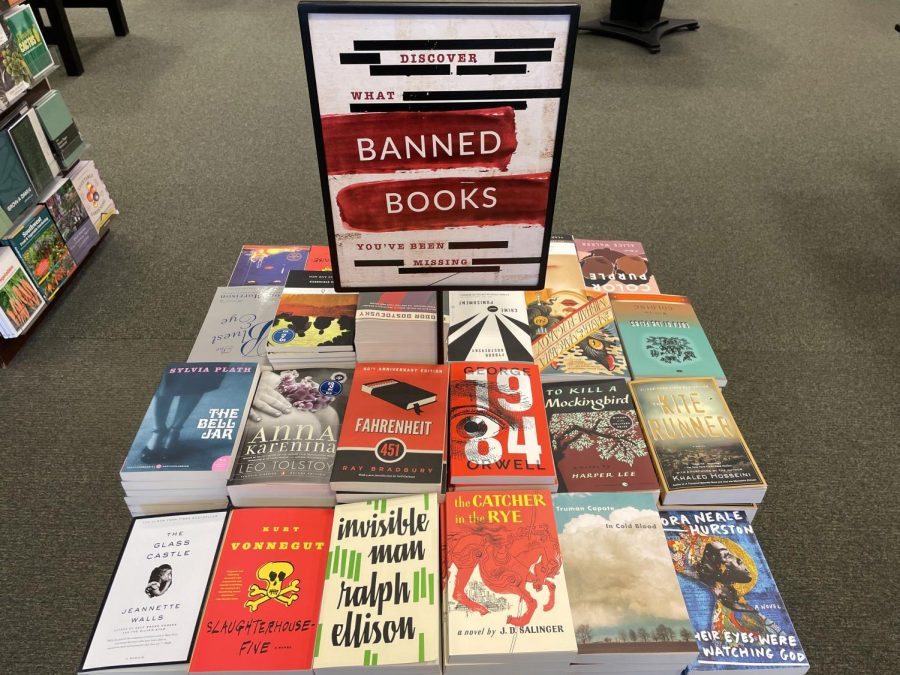FLYING OFF THE SHELVES FOR THE WRONG REASONS: Heating Arguments Between Republican Lawmakers and Bibliophiles
Banned books are presented within Barnes & Noble with a sign saying, “Discover what you’ve been missing.” A variety of books are presented including “Anna Karenina”, “Fahrenheit 451”, “1984”, “To Kill a Mockingbird” and “The Catcher in the Rye.”
Controversy is on the rise within the world of literature.
A recent dispute between legislators and the public regarding whether or not books should continue to be banned in certain school libraries, public libraries and states has become a more popularized instance than in recent years due to the censoring of books and charges against librarians and bookstores nationwide because of their beliefs.
Books such as “To Kill a Mockingbird,” “The Catcher in the Rye,” “1984,” “Anna Karenina,” “Fahrenheit 451,” “The Lord of the Flies,” “The Great Gatsby” and “Crime and Punishment” are all popular books that have been banned within the United States since their release to the public.
These are also all books that are studied within Sage Creek High School’s curriculum.

English teacher Emily Kalberg is able to see both sides of the argument.
“I think there shouldn’t be so many banned books,” Kalberg said. “We read them and analyze them for a reason, and I feel like some books that are banned have strong language. We could have a different book that focuses on the same culture and same ideas but doesn’t use that vulgar of language.”
According to the ALA (The American Library Association), the top three reasons a book may be “challenged” or banned in a specific city or state are due to “sexually explicit content, offensive language, and material that is unsuitable to an age group.” If a book is deemed inappropriate by an individual under one of these constructs, they have the ability to “challenge” the book and potentially remove the book from shelves, publishers and available bookstores.
Kalberg continued to note that books are very important to expanding students’ perspectives, cultures and overall viewpoints on the world.
“You can’t just have this one view in life – you have to understand that there are multiple types of people, beliefs and values, and reading diverse books allows students to not only feel connected if they can relate but also allows the other students to understand different viewpoints.” Kalberg said. “The world is full of diversity and that’s what makes it beautiful and creative.”
Kalberg isn’t the only teacher at SCHS that believes in the power and knowledge reading a single book can hold. Matt Haupert, an English and Sage Yearbook teacher, strongly believes in the power an educational facility can hold in supporting students and their abilities to think freely.
Haupert acknowledged, “When you start banning books, you begin curating what kids are exposed to and not exposed to. The function of education is to develop independent critical thinkers that can go into the strange world and figure out how we should move forward as a society.”
As a new father, however, Haupert is able to recognize the viewpoint of parents who are concerned about the teachings and content of books being taught in schools and what their children are being exposed to.
“I think a lot of the concerns come from an understandable place of parents wanting to protect their kids, which is where a lot of it stems from,” Haupert granted. “But there’s a distinction between what we’re requiring kids to read versus what is made accessible to them in the community. “

The opposing opinions arose within news and media publications most recently due to the censorship of certain wording within Roald Dahl’s “Matilda,” “Charlie and the Chocolate Factory,” “James and the Giant Peach” and “Fantastic Mr. Fox.” Along with numerous bookstore owners and school/city librarians facing fines and possible jail time for refusing to oblige by the challenging of certain books. All causing the spotlight to be on this sensitive subject frequently.
Jesse Pugliese, the assistant manager at Barnes & Noble in Oceanside, feels that in light of not only recent controversy but also the deed of banning books as a whole is something that reflects negatively on society.
“I think it’s pretty negative, limiting what students are able to read. It limits the opinions they’re able to express on their own,” Pugliese explained. “The good thing is that a lot of English teachers and English departments in most schools are very conscientious of books that are banned now or have been in the past, and they make a point of putting them into their curriculum for that reason – which is a good thing!”
When shoppers walk into the Barnes & Noble store, tables of books with various signs are found at the entrance. One of these tables contains stacks of books identified as, “Banned Books: Discover What You’ve Been Missing”.
Books are being ironically advertised as “banned,” which can lead customers to purchase them simply because they have been labeled in a certain way. According to PEN, 2,532 books were banned ranging from July 2021 to June 2022.
Haupert, like many other readers, contended that instead individuals should simply “Find the books that speak to you.”
“Everyone should read,” Haupert said. “It’s important for people to read a lot because the more you read and the wider variety of what you read, the more of a critical thinker you become the more nuanced you become. You should read whatever piques your interest.”



Lakin St ◊ Mar 11, 2023 at 4:59 pm
“When shoppers walk into the Barnes & Noble store, tables of books with various signs are found at the entrance. One of these tables contains stacks of books identified as, ‘Banned Books: Discover What You’ve Been Missing’.”
This fetishization of “banned books” seems pretty obviously to be a distraction. I’ve been to Barnes & Noble; multiple locations have this table in different forms. What you will not find is any *nonfiction* novels on this stand (occasionally there are “provocative” autobiographies). These tables are crowded with books from this or that author (Owell is a particularly ironic case since the animated film adaptation of his book Animal Farm was produced completely by the CIA) writing of fictional events filled with fictional characters and fictional messages. Is this because the United States does not suppress novels discussing real events? Not officially.
To quote the prelude to William G. Burchett’s “This Monstrous War” (a book discussing U.S. atrocities in the Korean War and doing away with the former’s pretexts):
“This is the first time this book is appearing in the United States. According to Gavan McCormack, “in the United States the entire consignment of the book (500 copies) was seized by US Customs and dumped in the sea on its arrival in that country late in the same year (1953), and as a result no major American library possesses a copy to this day” (Waters).
Or take Victor Marchetti and John D. Marks’ “The CIA and the Cult of Intelligence”, which the U.S. government went to court to suppress. Of course such a claim to ‘national security concerns’ legitimized the contents of the book, which unilaterally demonstrated the CIA’s use of illegal subversive and imperialist tactics, even after the government mandated the sanitization of certain contents of the novel.
Referring to the introduction to the Forbidden Bookshelf series of reprints, which can be found as a prelude to the new Open Road print of Douglas Valentine’s “The Phoenix Program: America’s Use of Terror in Vietnam” (contents self-explanatory), originally published in 1990: “We the people seem to have the freest book trade in the world. Certainly we have the biggest. Cruise the mighty Amazon, and you will see so many books for sale in the United States today as would require more than four hundred miles of shelving to display them—a bookshelf that would stretch from Boston’s Old North Church to Fort McHenry in South Baltimore.
Surely that huge catalog is proof of our extraordinary freedom of expression: The US government does not ban books, because the First Amendment won’t allow it. While books are widely banned in states like China and Iran, no book may be forbidden by the US government at any level (although the CIA censors books by former officers). Where books are banned in the United States, the censors tend to be private organizations- church groups, school boards, and other local (busy)bodies roused to purify the public schools or libraries nearby. Despite such local prohibitions, we can surely find any book we want.
After all, it’s easy to locate those hot works that once were banned by the government as too ‘obscene’ to sell, or mail, until the courts ruled otherwise on First Amendment grounds—Fanny Hill, Howl, Naked Lunch. We also have no trouble finding books banned here and there as ‘antifamily,’ ‘Satanic,’ ‘racist,’ and/or ‘filthy,’ from Huckleberry Finn to Heather Has Two Mommies to the Harry Potter series, just to name a few… And yet, the fact that those bold books are all in print, and widely read, does not mean that we have the freest book trade in the world. On the contrary: For over half a century, America’s vast literary culture has been disparately policed, and imperceptibly contained, by state and corporate entities well placed and perfectly equipped to wipe out wayward writings. Their ad hoc suppressions through the years have been far more effectual than those quixotic bans imposed on classics like The Catcher in the Rye and Fahrenheit 451. For every one of those bestsellers scandalously purged from some provincial school curriculum, there are many others (we can’t know how many) that have been so thoroughly erased that few of us, if any, can remember them, or have ever heard of them
Some almost never made it into print, as publishers were privately warned off them from on high, either on the grounds of ‘national security’ or with blunt threats of endless corporate litigation. Other books were signed enthusiastically—then ‘dumped,’ as their own publishers mysteriously failed to market them, or even properly distribute them. But it has mainly been the press that stamps out inconvenient books, either by ignoring them, or—most often—laughing them off as ‘conspiracy theory,’ despite their soundness (or because of it).
Once out of print, those books are gone. Even if some few of us have not forgotten them, and one might find used copies here and there, these books have disappeared. Missing from the shelves and never mentioned in the press (and seldom mentioned even in our schools), each book thus neutralized might just as well have been destroyed en masse—or never written in the first place, for all their contribution to the public good” (Miller).
What we have is an extremely evident diversion of the discussion of class suppression of real events and dissent thereof towards the consumption of more empty commodities. We must hope that the system may not fall asunder upon the crushing blow of another sale of Fahrenheit 451 or The Great Gatsby.